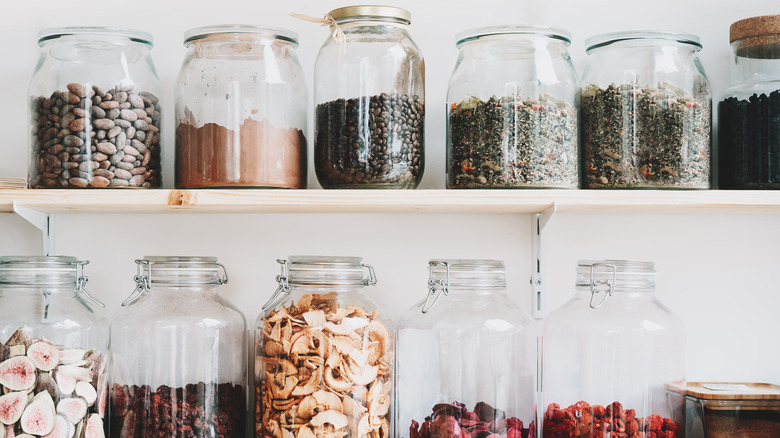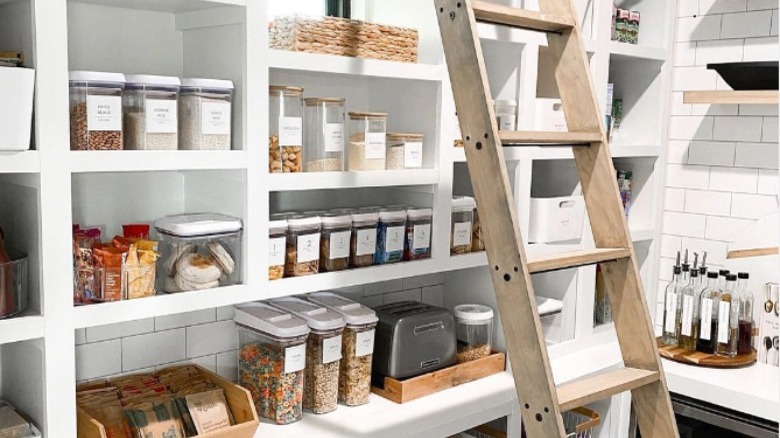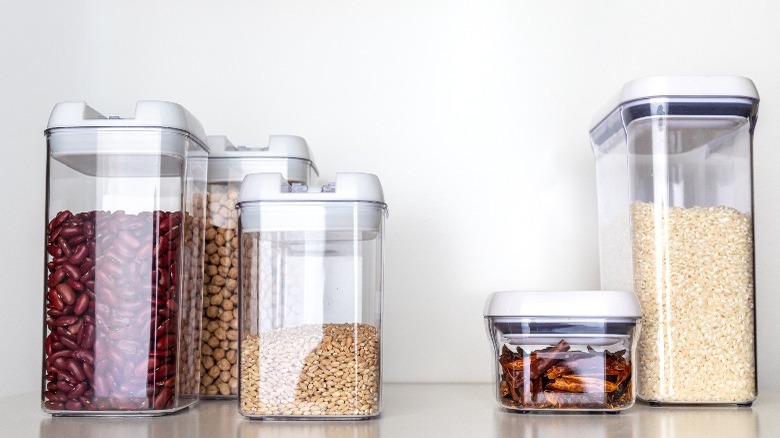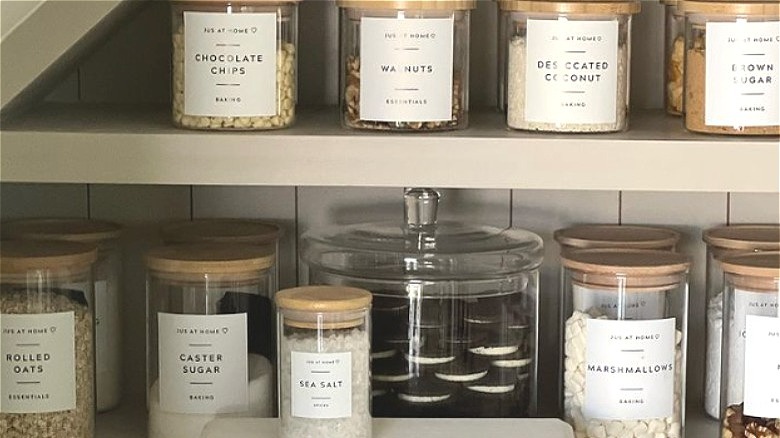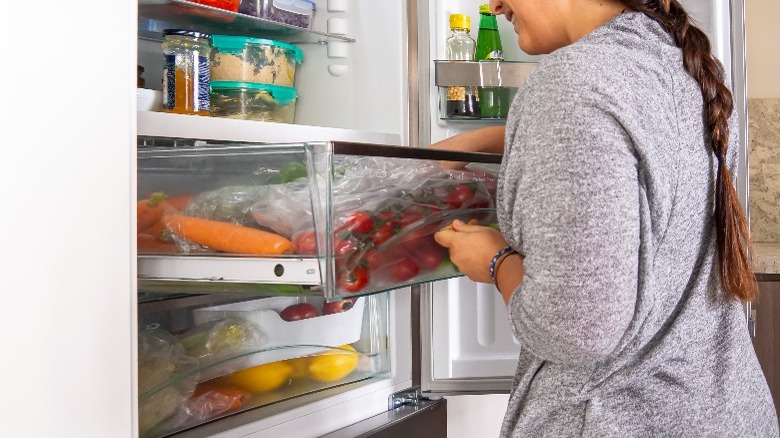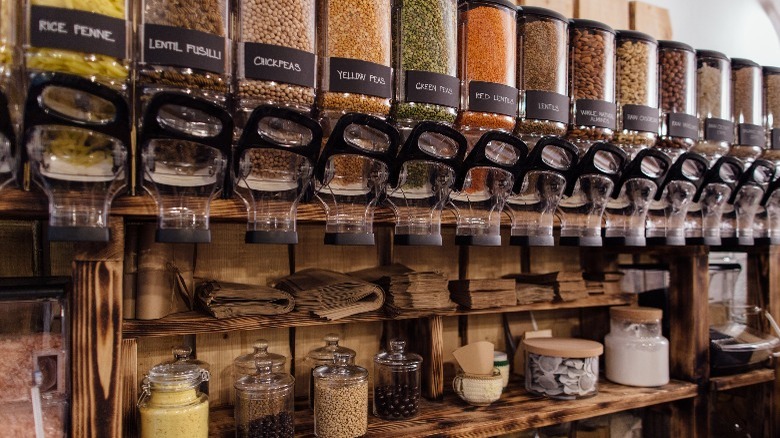5 Tips For Making Clear Storage Containers Work For Your Pantry
The divinely decanted pantry is a physical example of an organized and beautiful life — pleasingly uniform and transparent vessels filled with appealing foodstuffs. It is abundance on display, and it feels and looks good. The pantry is the hub of quick meals and kitchen magic. But how do we obtain this level of organization and contain the chaos in the cupboards? If starting from crammed boxes, crumpled bags, or a tight budget, you probably think this storage situation is out of reach, along with the lingering and expired things on the top shelf. But we're here to decode and label the mysteries.
Wirecutter asserts that satisfactory dry-food storage containers will keep contents fresher longer and withstand multiple drops, washes, and even overnights outside. Additionally, the outlet credits a good seal, various sizes, and lightweight and stackable traits to aim for. Though it can be a substantial upfront investment, they note that proper pantry storage will provide savings in both time and money. Plus, it's Instagrammable — search #pantryorganization and #foodstorage for inspiration. Remember, the goal is to eat with more than your eyes, so acquire only what you'll use. According to the Mayo Clinic, food waste in the U.S. exceeds 30% each year. They recommend a few practices to reduce in-home food waste, including taking stock before shopping, storing supplies correctly, and buying imperfect produce. For the sake of aesthetics, you could place a large label over those items. Find more clear storage tips below.
1. Pick a space and maximize it
It's important to know where your canisters will be kept. To that end, HGTV suggests first deciding on a spot for your storage system. For example, you might like to house items near where corresponding tasks are performed, such as baking supplies by your cake-making or dough-rolling station or coffee gear next to the espresso machine. Perhaps an organized and easy-to-see display of goods in a concealed closet or cupboard is the objective. And don't dismiss the fridge or freezer as a pantry location that deserves orderly and efficient storage. Well+Good recommends keeping nuts and seeds in the refrigerator because of their high oil content. Additionally, they say flour and matcha should be stored there too. If your food organization needs a complete overhaul, it could be worthwhile to address the above.
After the areas have been chosen, you can assess some critical considerations. Are the shelves adjustable? What are the maximum allowable height and depth of the containers? Which sizes will be most desired? And which items should be given priority in accessibility? Furthermore, once you begin shopping, look for canisters that are available in multiple dimensions and can be stacked to maximize space. Wirecutter rated several brands of dry-food containers and noted their top choice was sold in various sizes and shapes and was both narrow and stackable. Food52 claims square and rectangular versions are better than round. Other beneficial options may be materials that are dishwasher and freezer-safe.
2. Choose air and water-proof lids
Per Food52, the lids on your storage containers must latch soundly and are both air and water-tight. This is especially important for aromatic and liquid contents. The food-centric blog and kitchenware retailer even recommends purchasing one piece before buying in multitudes and taking it for a test run: shake it, knock it over, and travel with it, for example. In addition, a strong seal means an environment much less amenable to pests. The University of Minnesota Extension explains that seeds, nuts, dried fruits, pasta, flour, cereal products, snacks, and grains, are particularly susceptible to infestation. Some pests can chew through unopened boxes and bags and spread to other items in the pantry and throughout additional areas of the house. To be preventative, they recommend storing food in tightly sealed, sturdy plastic and glass containers.
Food52 notes that attached clamp-style lids fasten securely and are less likely to be misplaced, yet they concede they can be difficult to wash. Covers that are tight-sealing and dishwasher-safe receive high approval from professional cooks and testers. Sana Javeri Kadri, CEO of spice company Diaspora Co., relayed to Food & Wine that while she doesn't decant her spices because she uses them up so rapidly, she does rely on airtight storage for certain staples and prefers a type with snapping closures. A pop-handle lid is another favorite among reviewers.
3. Label everything
According to the recipe curation site Epicurious, food storage containers should always be labeled. They suggest that labeling makes it simpler to keep track of your inventory when it's time to restock. It also decreases the opportunity of confusing one item for another, which can happen too readily during the frenzy of dinner prep or when the kitchen timer is ticking. Baking soda and baking powder quickly come to mind as candidates for a mix-up. And if you're embarking on new eating habits that require unfamiliar ingredients, such as dried grains, legumes, or nut flours, it makes sense to label them until they're more recognizable. In addition to the name of the contents, Epicurious recommends listing the expiration date; if none is available, as on bulk goods, use the purchase date instead. Further, consider attaching the cooking method or the primary recipe the item appears in to save steps later.
There are several label types to employ, including those printed with a label-maker, digital designs printed on adhesive paper (like the personalized ones above by jusathome), purchased pre-printed or erasable options, chalkboard paint, and removable tape and permanent marker. Some canisters come with labels intact; Taste of Home featured a style with a large black label and a white gel marker. The aesthetics are up to you and your containers. However, function and safety take precedence in the kitchen, so make sure your preferred medium is easy to read and utilize.
4. Use multi-functional materials
Multi-tasking is the happy homemaker's friend. In all aspects, dual or triple functionality saves money, space, and time not spent searching for new items. Consequently, pantry storage containers can be enlisted to do more than keep dry foods fresh and insect-free. Provided the materials and styles allow, they can also store leftovers, tote work lunches, be heated in the microwave, or be stuck in the deep freeze, to name a few. Check the manufacturer's descriptions to determine what your prospective pieces can withstand.
As mentioned via The Washington Post, some food products fare better in the refrigerator or freezer, including yeast, whole-grain flour, and nuts. Clear containers make it easier to access and consume food stored there before it can spoil — a constant kitchen struggle, hence the popularity of fridge clean-out dinners. Additionally, consider sticking with one family of products, which may be able to share lids, nest into one another when not in use, and stack together for space efficiency.
5. Take them shopping with you
Many groceries and coops now feature a bulk goods section. According to Civil Eats, the trend is growing as consumers aim to lessen their reliance on food packaging and hence their contribution to pollution. Shopping for items from the bulk bins can be more economical; they're frequently less expensive as there are no bags, boxes, or catchy slogans to pay for. Additionally, you can buy just the quantity needed for a recipe or menu plan, effectively reducing food waste. Per the Rooted Life, that smaller amount will be gone through faster, and there is generally a quicker turnover in bulk food departments — both factors equate to a fresher product.
Often stores will allow outside storage containers to be carried in. This again reduces plastic bag use and streamlines the process at home. Empty canisters can be filled directly at the site, eliminating the step (and sometimes mess) of decanting later while ensuring the purchase of an amount that fits into the container with no excess. If the article has a PLU code, it will most likely need to be recorded on the container for the point of sale. In case you forget to add a label once you get home, that code can be used in the future to determine what the item is. Further, it helps ensure the restocking of the exact product when it's time to buy more — perfect on the occasion someone else offers to do the grocery run.
